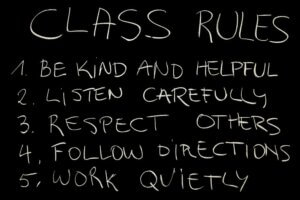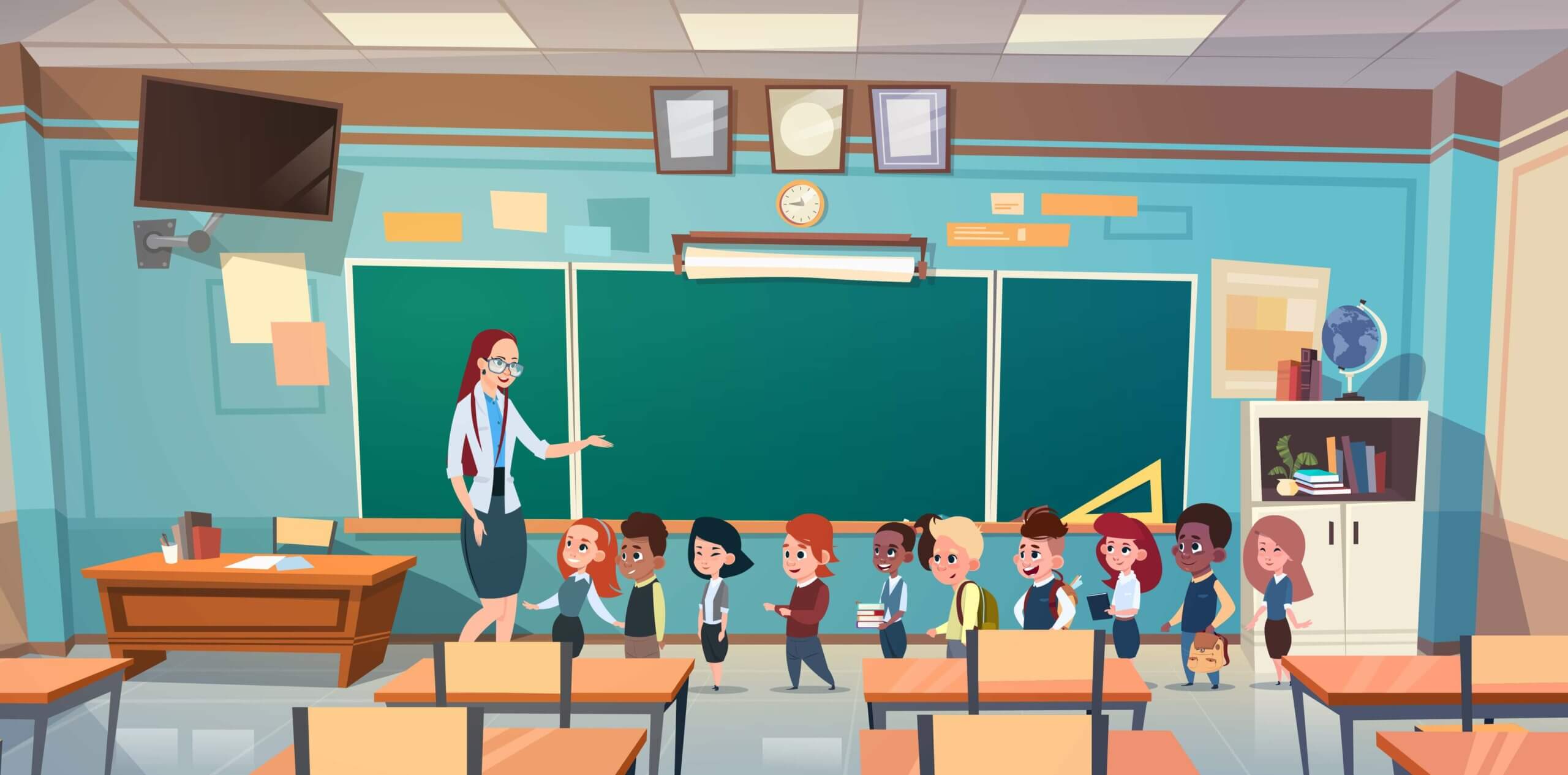How to Create and Reinforce Classroom Rules

All educational institutions, when dealing with rules and norms, start out with their internal regulations. This is a document related to rules of civil coexistence. So, when we talk about how to create and reinforce classroom rules, it’s very important to keep this point in mind.
Internal regulations apply to the entire educational institution, regardless of students’ age, level, or course. These are very broad rules that seek to establish and maintain harmony both inside and outside of the classroom.
While regulations set the foundation for establishing norms, many times, it’s necessary to develop them for each classroom. That’s because broader, more general rules tend to fall short. Many times, they’re too theoretical, and all are equally important. As a result, students perceive them as distant.
Students don’t participate in the process of creating institutional regulations. Therefore, they don’t feel any ownership regarding these rules, nor do they feel like these rules have anything to do with them. Rather, they feel like an external imposition.
So, how can you create and establish classroom rules that are effective? You need to put a twist on the institutional regulations and create specific norms for each class.
Types of classroom rules and how to reinforce them
In a quest to achieve effective classroom management, you need to establish the norms from the beginning of the year or semester. In that sense, we can divide these norms into general norms and specific norms.

General rules
General rules are so flexible that they can include practically all types of behaviors. In order to reinforce them, teachers need to explain them clearly so that all students understand them. What’s more, it’s important to remind students of them frequently.
For example, if the rule is “be responsible”, then you need to expand on the idea. Being responsible includes deciding things for one’s self, doing the right thing, being autonomous, etc.
At the same time, “be respectful” involves listening to others without interrupting, for example. And it also refers to things like putting yourself in someone else’s shoes, caring for one another’s property, etc.
Specific norms
Specific norms refer to much more specific behaviors. If you need classroom behavior to improve quickly and concretely, then these are the rules you’ll need. Over the course of the school year, you can develop these rules and even eliminate them as you see fit. In the same way, you can also add new rules or change their importance.
Progressive rules
To make rules more effective, you can also create progressive rules. These are those norms that you will expose a little at a time during each class session. It’s a way to establish rules on a gradual basis, rather than throwing them at students all at once. This method helps keep children from forgetting the rules.
Putting rules into practice
There’s no point in explaining the rules if you don’t put them into practice. Saying them out loud is just that – enunciation. But when a concrete case occurs that presents the possibility of applying a given rule, this is when students can identify with the rules.

As students come to learn the rules, they can explain possible real cases where the rules we’re talking about aren’t being met. This may be because they’re aware of these cases, or because they think this could occur in a concrete situation.
Rules and their expression
To reinforce rules in the classroom, it may be helpful to illustrate them. To do so, divide students into groups and assign a norm to each group. Allow them to create a mural of the norm and all that it embarks. This is a good way for them to internalize the rules and take ownership of them.
The purpose of the rule
It’s not enough just to create and reinforce classroom rules. Students need to understand why they exist, why they’re essential, and what their purpose is. Rules are always useful when it comes to improving, developing as people, being responsible… So make sure to explain and discuss the purpose of each rule when you establish it.
Conclusion regarding how to create and reinforce classroom rules
In short, there are many things to keep in mind when thinking about rules. Knowing how to create and reinforce them is a fundamental part of any teacher’s job. By following these simple rules, the task will be much easier to fulfill.
All educational institutions, when dealing with rules and norms, start out with their internal regulations. This is a document related to rules of civil coexistence. So, when we talk about how to create and reinforce classroom rules, it’s very important to keep this point in mind.
Internal regulations apply to the entire educational institution, regardless of students’ age, level, or course. These are very broad rules that seek to establish and maintain harmony both inside and outside of the classroom.
While regulations set the foundation for establishing norms, many times, it’s necessary to develop them for each classroom. That’s because broader, more general rules tend to fall short. Many times, they’re too theoretical, and all are equally important. As a result, students perceive them as distant.
Students don’t participate in the process of creating institutional regulations. Therefore, they don’t feel any ownership regarding these rules, nor do they feel like these rules have anything to do with them. Rather, they feel like an external imposition.
So, how can you create and establish classroom rules that are effective? You need to put a twist on the institutional regulations and create specific norms for each class.
Types of classroom rules and how to reinforce them
In a quest to achieve effective classroom management, you need to establish the norms from the beginning of the year or semester. In that sense, we can divide these norms into general norms and specific norms.

General rules
General rules are so flexible that they can include practically all types of behaviors. In order to reinforce them, teachers need to explain them clearly so that all students understand them. What’s more, it’s important to remind students of them frequently.
For example, if the rule is “be responsible”, then you need to expand on the idea. Being responsible includes deciding things for one’s self, doing the right thing, being autonomous, etc.
At the same time, “be respectful” involves listening to others without interrupting, for example. And it also refers to things like putting yourself in someone else’s shoes, caring for one another’s property, etc.
Specific norms
Specific norms refer to much more specific behaviors. If you need classroom behavior to improve quickly and concretely, then these are the rules you’ll need. Over the course of the school year, you can develop these rules and even eliminate them as you see fit. In the same way, you can also add new rules or change their importance.
Progressive rules
To make rules more effective, you can also create progressive rules. These are those norms that you will expose a little at a time during each class session. It’s a way to establish rules on a gradual basis, rather than throwing them at students all at once. This method helps keep children from forgetting the rules.
Putting rules into practice
There’s no point in explaining the rules if you don’t put them into practice. Saying them out loud is just that – enunciation. But when a concrete case occurs that presents the possibility of applying a given rule, this is when students can identify with the rules.

As students come to learn the rules, they can explain possible real cases where the rules we’re talking about aren’t being met. This may be because they’re aware of these cases, or because they think this could occur in a concrete situation.
Rules and their expression
To reinforce rules in the classroom, it may be helpful to illustrate them. To do so, divide students into groups and assign a norm to each group. Allow them to create a mural of the norm and all that it embarks. This is a good way for them to internalize the rules and take ownership of them.
The purpose of the rule
It’s not enough just to create and reinforce classroom rules. Students need to understand why they exist, why they’re essential, and what their purpose is. Rules are always useful when it comes to improving, developing as people, being responsible… So make sure to explain and discuss the purpose of each rule when you establish it.
Conclusion regarding how to create and reinforce classroom rules
In short, there are many things to keep in mind when thinking about rules. Knowing how to create and reinforce them is a fundamental part of any teacher’s job. By following these simple rules, the task will be much easier to fulfill.
All cited sources were thoroughly reviewed by our team to ensure their quality, reliability, currency, and validity. The bibliography of this article was considered reliable and of academic or scientific accuracy.
- Johnson, Lois V., L. V. Johnson, y Bany Marya. Classroom management. Macmillan Company Collier. 1983.
This text is provided for informational purposes only and does not replace consultation with a professional. If in doubt, consult your specialist.








